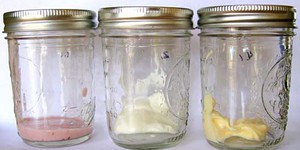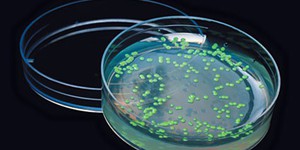Others Like “The Art & Science of Making Yummy Yogurt” (top 20 results)
|
Has a milk-based soup, sauce, or gravy ever curdled on you (formed lumps) as you were preparing it? Curdling is the process of coagulation that occurs where the proteins in the milk clump together. Sometimes curdling is desirable—for example, if you want to make a delicious cheese or yogurt—but if you are trying to make a milk-based soup or gratin, or if you're adding milk to a hot drink, curdling is very unwanted because you lose the smooth, creamy texture. Nobody likes clumps and…
Read more
Have you ever wondered how yogurt is made and what makes some yogurts different from other yogurts? You may have noticed that most yogurt containers advertise that the yogurt contains "live cultures." This means that there are living bacteria in the yogurt! These amazing bacteria can turn plain old milk into a yummy yogurt treat. In this science project, you will investigate whether the bacteria affect what the yogurt feels, tastes, and smells like by making your own yogurt at home!
Read more
What is expression cloning and how is it used in the biotechnology industry? How are plasmids constructed for use in a bacterial expression system? You can investigate these questions and more using bacterial expression kits meant for high school classes. You will need a laboratory space equipped to grow bacteria and carry out simple molecular biology. A kit with plasmids and bacterial cells to transform are also needed. Here are two possibilities:
BioBuilder What a Colorful World Kit …
Read more
Caramelization is the name of the cooking process that occurs as sugar is heated and the molecules begin to break apart. But what happens to the sugar as it breaks apart? And what do the physical changes mean for the flavor of the sugar? Using the Internet or cookbooks, read up on the chemistry of caramelization, then head to the kitchen with an adult to caramelize your own batch of sugar. With an adult's help, dissolve 1 1/3 cups of sugar in 2/3 cup of water. Heat the mixture in a pan over…
Read more
Chlorophyll is a natural pigment found in green plants. It is the primary pigment that absorbs light energy from the sun for photosynthesis. This energy is then used by the plant to synthesize glucose from carbon dioxide and water. Chlorophyll in the leaves of plants can be extracted and separated using chromatography. A good source of chlorophyll for an extraction is a dark green leafy vegetable like spinach. Rub a fresh spinach leaf on the bottom of a strip of filter paper. You can get a…
Read more
Minerals are sometimes precious, like diamonds. But most minerals are very common, like sodium, which is found in salt. How are minerals found and identified? How are our mineral resources distributed? Visit the USGS Mineral Resource Program to find mineral resources in your state. How are satellite images used to identify potential mineral sources? You can also find out how minerals are identified using spectroscopy. How are potentially harmful minerals, like mercury, dealt with? Visit the…
Read more
Soil may look like a bunch of dirt, but good quality soil is actually a complex mixture of dirt, nutrients, microorganisms, insects and worms. What type of benefit do these microorganisms offer a growing plant? You can test this by baking soil in the oven to sterilize and kill the microorganisms. Do plants grown in sterile soil do better than plants in unsterilized soil? What about adding worms to one plant, but not to the other. Will the plant with worms grow better? Some insects are bad…
Read more
Plant stems grow through a process of elongation due to cell divisions within the stem. Does the entire length of the stem elongate evenly? Or do certain regions along the plant stem grow more or less than others? Regions that are involved in active growth are called vegetative. You can conduct an experiment to show which regions of a bean seedling are involved in vegetative growth. Use a marker to mark one inch sections along the main stem of a young bean seedling. Number the regions 1-6…
Read more
If you browse through a candy cookbook, you might notice that many of the recipes call for corn syrup in addition to sugar. Both sugar and corn syrup are sweet, so why do you need corn syrup if you already have sugar? In candy making, corn syrup is known as an interfering agent. But what does this mean and how does it work? You can find out for yourself by making two batches of rock candy, one with corn syrup and one without. For example, you could alter the science project When Science is…
Read more
When you take medicine, it needs to dissolve in order to be passed into your bloodstream to have an effect. On the other hand, the drug needs to be packed into a small, dense pill to make it easier to swallow. How does the delivery method of a drug change how quickly it enters the bloodstream? Compare different brands of a drug to find out which brands dissolve the quickest. Does the pH of the stomach (which is usually between 1 and 2) matter? Compare coated to uncoated pills: does the coating…
Read more
|
Explore Our Science Videos
Build a Machine to Lift Water - STEM Lesson Plan
How to Build a Toy Car - Science Project
How Far Can a Sneeze Go?








